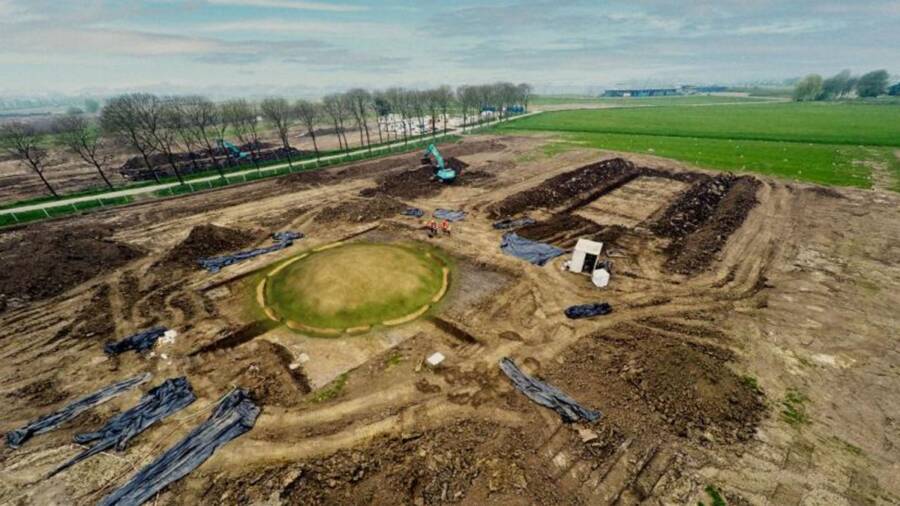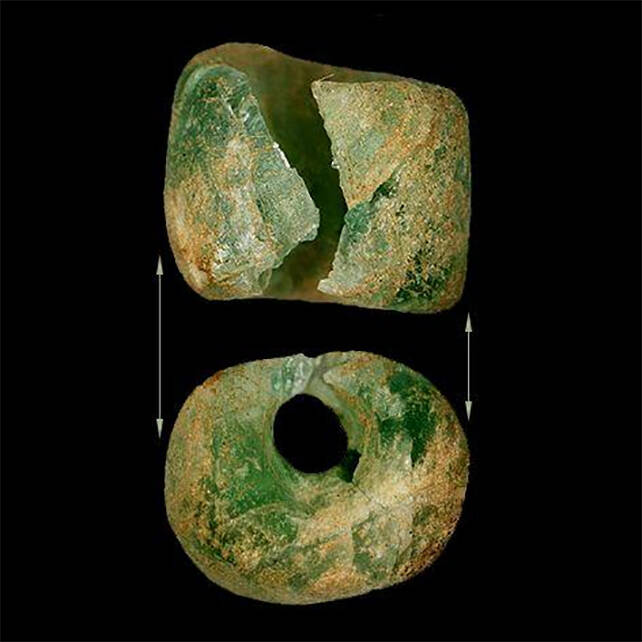Archaeologists excavating an ancient religious sanctuary discovered a large burial mound that seemed to serve as a solar calendar, leading some to dub it the "Stonehenge of the Netherlands."

Municipality of TielThe site is around 4,000 years old and served a similar purpose to the English Stonehenge.
At a former industrial estate in the Dutch municipality of Tiel, archaeologists have uncovered a 4,000-year-old religious site with earthen mounds. They believe that the site, designed to align with the Sun, may have served as a solar calendar similar to Stonehenge in England.
“This sanctuary must have been a highly significant place where people kept track of special days in the year, performed rituals and buried their dead. Rows of poles stood along pathways used for processions,” explained a translated statement from the Municipality of Tiel.
The site, which stretched across more than nine acres, contains three burial mounds as well as several passages where the Sun would have shone directly on the shortest and longest days of the year.
Though the religious sanctuary doesn’t have a rock formation like the English Stonehenge, the largest burial mound of the “Stonehenge of the Netherlands” likely served as a calendar which ancient people used to track the Sun’s movements.
“The largest hill had a diameter of 20 meters and served as a kind of solar calendar,” the Municipality of Tiel statement explained. “Around the largest mound was a shallow ditch with several passages. On certain days the Sun shone straight through those passages on the hill. The most important days were June 21, the summer solstice (longest day) and December 21, the winter solstice (shortest day). Archaeologists also found offerings in places where the Sun shone straight through the openings.”
Researchers also found the remains of more than 80 people who had been buried at the site over a period of 800 years, Live Science reports. The largest mound contained men, women and “a remarkable number of children” who died between about 2500 B.C.E and 1200 B.C.E. Some of the bodies were buried, and some of them had been cremated.
“These deceased,” the statement explained, “must have played an important role in [the site’s] rituals.”

Municipality of TielThe Stonehenge of the Netherlands today, with virtual grass overlaid atop what was once the largest burial mound.
That wasn’t all that archaeologists discovered at the site, however. Over their six-year excavation and analysis, they also uncovered more than 1 million other objects made from pottery, bone, clay, stone, flint, and wood that date from the Stone Age, Bronze Age, Iron Age, Roman Empire and Middle Ages.
“Rarely do archaeologists get the chance to excavate so much terrain around burial mounds,” the archaeologists noted in their statement. “Now it is clear how unique this find and this sanctuary [are].”
One of the most remarkable objects found at the Stonehenge of the Netherlands was a tiny glass bead buried with a woman. The bead originated in Mesopotamia (present-day Iraq) and proves that ancient people in the Netherlands were in contact with people more than 3,000 miles away.
“Glass was not made here, so the bead must have been a spectacular item as for people then it was an unknown material,” Stijn Arnoldussen, a professor at the University of Groningen, told The Guardian.
He noted that the bead could have been around for centuries before landing in the burial site, adding: “Things were already being exchanged in those times. The bead may have been above ground for hundreds of years before it reached Tiel.”

Municipality of TielThis glass bead, found in a woman’s grave, proves that ancient people in the Netherlands were in contact with civilizations more than 3,000 miles away.
The site will not be open to the public, for the simple reason that there’s nothing to see there.
“There is nothing to see at the location now,” the statement explained. “What the archaeologists found are traces in the ground; some kind of footprints. The reconstruction of what once was is spectacular.”
Now, researchers are deciding on how to best present their findings about the Stonehenge of the Netherlands to the world.
“We are now thinking about how we tell the story to the public,” Frank Groen, an alderman in Tiel, explained in the statement. “For example through a documentary or more images about how people lived thousands of years ago. Some finds [will] go to the Flipje and Streekmuseum in Tiel and to the National Museum of Antiquities in Leiden.”
After reading about the discovery of the Stonehenge of the Netherlands, learn about the “German Stonehenge,” a Bronze Age site used for ritual child sacrifices. Or, see why some believe that the design for the English Stonehenge actually originated in France.





